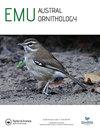在阿根廷,种子偏好表明黄色红衣主教(Gubernatrix cristata)极易受到生境退化的影响
IF 1.1
4区 生物学
Q3 ORNITHOLOGY
引用次数: 0
摘要
黄红衣主教是南美洲南部特有的全球濒危物种。近年来,对其一般生物学的了解有所增加,但其摄食生态学却鲜为人知。评估濒危物种的喂养生态会带来伦理困境,因此,我们利用护林员在阿根廷门多萨蒙特沙漠中从非法贩运中救出的黄雀,通过使用两种不同的种子集来实验评估它们的种子偏好,以验证以下假设:(1)鸟类更喜欢本地禾草物种的中型和大型种子,这些种子是被牛放牧减少最多的种子;(2)鸟类无法处理和食用非本地作物物种典型的大种子。选择实验和非选择实验相结合来评估种子的偏好。在8种乡土种子<1 mg(4种禾本科种子,4种禾本科种子)的实验中,鸟类对大中型禾本科种子的偏好高于对禾本科种子的偏好。实验用8种草籽(4种原生草籽,4种商品草籽;0.23-33毫克)的鸟类难以处理最重的种子,阈值在7 - 25毫克之间。这一困难可能解释了黄色红衣主教与野生稀树草原和旱生灌木的积极联系,而不是与农业领域,因为普通作物有大种子(40-350毫克)。鉴于物种对经常用于畜牧业的生境的亲和力,由于主要食物资源的减少,过度放牧应作为生境退化的一个原因包括在内。本文章由计算机程序翻译,如有差异,请以英文原文为准。
Seed preferences suggest a high vulnerability of the Yellow Cardinal (Gubernatrix cristata) to habitat degradation in Argentina
ABSTRACT The Yellow Cardinal is a globally endangered species endemic of southern South America. Knowledge of its general biology has increased in recent years, but its feeding ecology is less well-known. Assessing the feeding ecology of endangered species imposes ethical dilemmas, and we therefore took advantage of Yellow Cardinals rescued by rangers from illegal trafficking in the Monte desert, Mendoza, Argentina, to experimentally assess their seed preferences by using two different seed sets to test the hypotheses that (1) the birds prefer medium-sized and large seeds of native grass species, which are the seeds that are most reduced by cattle grazing, and (2) birds are not able to handle and consume the large seeds typical of non-native crop species. Choice and non-choice experiments were combined to assess the seed preferences. In the experiments with eight native seeds <1 mg (4 grasses, 4 forbs) the birds preferred the medium-sized and large grass seeds over the forb seeds. In the experiment with eight grass seeds (4 native, 4 commercial; 0.23–33 mg) birds had difficulty in handling the heaviest seeds, with a threshold between 7 and 25 mg. This difficulty might explain the positive association of the Yellow Cardinal with wild savannahs and xerophytic shrubland but not with agricultural fields, since common crops have large seeds (40–350 mg). Given the species affinity for habitats that are often used for livestock ranching, overgrazing should be included as a source of habitat degradation due to the reduction in key food resources.
求助全文
通过发布文献求助,成功后即可免费获取论文全文。
去求助
来源期刊

Emu-Austral Ornithology
生物-鸟类学
CiteScore
2.00
自引率
7.70%
发文量
33
审稿时长
>12 weeks
期刊介绍:
Emu – Austral Ornithology is the premier journal for ornithological research and reviews related to the Southern Hemisphere and adjacent tropics. The journal has a long and proud tradition of publishing articles on many aspects of the biology of birds, particularly their conservation and management.
 求助内容:
求助内容: 应助结果提醒方式:
应助结果提醒方式:


